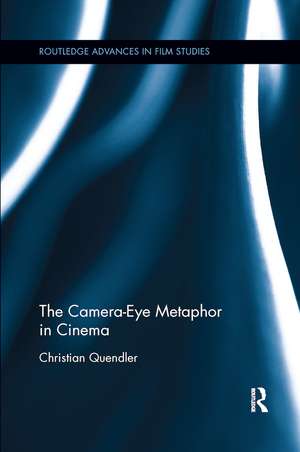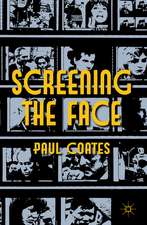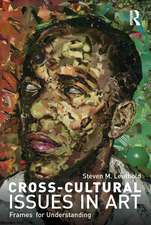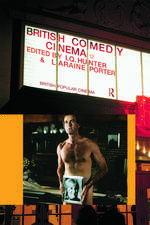The Camera-Eye Metaphor in Cinema: Routledge Advances in Film Studies
Autor Christian Quendleren Limba Engleză Paperback – 10 dec 2019
| Toate formatele și edițiile | Preț | Express |
|---|---|---|
| Paperback (1) | 376.10 lei 6-8 săpt. | |
| Taylor & Francis – 10 dec 2019 | 376.10 lei 6-8 săpt. | |
| Hardback (1) | 1001.84 lei 6-8 săpt. | |
| Taylor & Francis – 10 noi 2016 | 1001.84 lei 6-8 săpt. |
Din seria Routledge Advances in Film Studies
-
 Preț: 304.12 lei
Preț: 304.12 lei -
 Preț: 310.14 lei
Preț: 310.14 lei -
 Preț: 349.00 lei
Preț: 349.00 lei -
 Preț: 301.92 lei
Preț: 301.92 lei -
 Preț: 310.65 lei
Preț: 310.65 lei -
 Preț: 310.85 lei
Preț: 310.85 lei -
 Preț: 313.47 lei
Preț: 313.47 lei -
 Preț: 364.89 lei
Preț: 364.89 lei -
 Preț: 341.63 lei
Preț: 341.63 lei -
 Preț: 349.09 lei
Preț: 349.09 lei - 18%
 Preț: 1106.81 lei
Preț: 1106.81 lei -
 Preț: 416.06 lei
Preț: 416.06 lei - 18%
 Preț: 1116.02 lei
Preț: 1116.02 lei -
 Preț: 449.05 lei
Preț: 449.05 lei -
 Preț: 388.85 lei
Preț: 388.85 lei - 18%
 Preț: 1112.21 lei
Preț: 1112.21 lei - 18%
 Preț: 1112.34 lei
Preț: 1112.34 lei - 18%
 Preț: 1106.81 lei
Preț: 1106.81 lei - 18%
 Preț: 1106.85 lei
Preț: 1106.85 lei -
 Preț: 382.86 lei
Preț: 382.86 lei -
 Preț: 477.56 lei
Preț: 477.56 lei -
 Preț: 441.20 lei
Preț: 441.20 lei -
 Preț: 387.31 lei
Preț: 387.31 lei - 18%
 Preț: 729.62 lei
Preț: 729.62 lei - 18%
 Preț: 1056.95 lei
Preț: 1056.95 lei - 18%
 Preț: 1058.43 lei
Preț: 1058.43 lei - 18%
 Preț: 1161.62 lei
Preț: 1161.62 lei - 30%
 Preț: 848.15 lei
Preț: 848.15 lei - 18%
 Preț: 1109.99 lei
Preț: 1109.99 lei - 18%
 Preț: 1062.62 lei
Preț: 1062.62 lei -
 Preț: 398.48 lei
Preț: 398.48 lei - 18%
 Preț: 1117.43 lei
Preț: 1117.43 lei - 18%
 Preț: 1115.51 lei
Preț: 1115.51 lei - 18%
 Preț: 1114.30 lei
Preț: 1114.30 lei - 18%
 Preț: 1053.16 lei
Preț: 1053.16 lei - 18%
 Preț: 1057.75 lei
Preț: 1057.75 lei - 30%
 Preț: 820.32 lei
Preț: 820.32 lei - 18%
 Preț: 1112.34 lei
Preț: 1112.34 lei - 18%
 Preț: 1057.75 lei
Preț: 1057.75 lei - 18%
 Preț: 1117.43 lei
Preț: 1117.43 lei
Preț: 376.10 lei
Nou
Puncte Express: 564
Preț estimativ în valută:
71.97€ • 75.29$ • 59.78£
71.97€ • 75.29$ • 59.78£
Carte tipărită la comandă
Livrare economică 02-16 aprilie
Preluare comenzi: 021 569.72.76
Specificații
ISBN-13: 9780367873271
ISBN-10: 0367873273
Pagini: 262
Dimensiuni: 152 x 229 x 18 mm
Greutate: 0.45 kg
Ediția:1
Editura: Taylor & Francis
Colecția Routledge
Seria Routledge Advances in Film Studies
Locul publicării:Oxford, United Kingdom
ISBN-10: 0367873273
Pagini: 262
Dimensiuni: 152 x 229 x 18 mm
Greutate: 0.45 kg
Ediția:1
Editura: Taylor & Francis
Colecția Routledge
Seria Routledge Advances in Film Studies
Locul publicării:Oxford, United Kingdom
Public țintă
Postgraduate and UndergraduateCuprins
Introduction
1. Seeing-As
Playing with the Senses
Sensitive Paper and Visual Substance
Mechanical Brains and Electronic Minds
The Organic Camera Eye and Walter Benjamin’s Optical Unconscious
Convergent Theorizing in Jean-Louis Baudry’s Apparatus Theory
2. Seeing Better and Seeing More
Camera and Dispositif
René Descartes and Dziga Vertov on Perfecting Vision
Seeing Better with Vsevolod Pudovkin’s Cartesian Camera Eye
Seeing More with Vertov’s Kino-Eye
3. Seeing and Writing
Dziga Vertov’s Poetic Map of A Sixth Part of the World
The Literary Notebooks of Luigi Pirandello’s Silent Camera Operator
The Sound Image of John Dos Passos’ Camera Eye
Christopher Isherwood’s Camera Eye on Stage and Screen
4. Memory and Traces
A Series of Dated Traces
Margarete Böhme’s The Diary of a Lost One
Filming the Diary of a Lost Girl
William Keighley’s Journal of a Crime
Cinema as Paper Formatted in Time
5. Gestures and Figures
Embodied Gestures and Textual Figures
Autopsy and Autography
Cinematic Discovery of the Self
Filmic Bodies and Figures in Narrative Film Theory
From Lady in the Lake to La Femme défendue
6. Roles and Models
Personal Cinema as Institution, Medium and Genre
From Psychodrama to Life Models
Animating the Self in Jerome Hill’s Film Portrait
Stan Brakhage’s Metaphors and Art of Vision
Brakhage’s Development of Camera Consciousness
The Eye Body and the Body Politic in Carolee Schneemann’s Expanded Cinema
7. Minds and Screens
Bruce Kawin and Gilles Deleuze on Camera Consciousness
Visionary Agents in Michael Powell’s Peeping Tom and Bertrand Tavernier’s Death Watch
Enacted Vision
1. Seeing-As
Playing with the Senses
Sensitive Paper and Visual Substance
Mechanical Brains and Electronic Minds
The Organic Camera Eye and Walter Benjamin’s Optical Unconscious
Convergent Theorizing in Jean-Louis Baudry’s Apparatus Theory
2. Seeing Better and Seeing More
Camera and Dispositif
René Descartes and Dziga Vertov on Perfecting Vision
Seeing Better with Vsevolod Pudovkin’s Cartesian Camera Eye
Seeing More with Vertov’s Kino-Eye
3. Seeing and Writing
Dziga Vertov’s Poetic Map of A Sixth Part of the World
The Literary Notebooks of Luigi Pirandello’s Silent Camera Operator
The Sound Image of John Dos Passos’ Camera Eye
Christopher Isherwood’s Camera Eye on Stage and Screen
4. Memory and Traces
A Series of Dated Traces
Margarete Böhme’s The Diary of a Lost One
Filming the Diary of a Lost Girl
William Keighley’s Journal of a Crime
Cinema as Paper Formatted in Time
5. Gestures and Figures
Embodied Gestures and Textual Figures
Autopsy and Autography
Cinematic Discovery of the Self
Filmic Bodies and Figures in Narrative Film Theory
From Lady in the Lake to La Femme défendue
6. Roles and Models
Personal Cinema as Institution, Medium and Genre
From Psychodrama to Life Models
Animating the Self in Jerome Hill’s Film Portrait
Stan Brakhage’s Metaphors and Art of Vision
Brakhage’s Development of Camera Consciousness
The Eye Body and the Body Politic in Carolee Schneemann’s Expanded Cinema
7. Minds and Screens
Bruce Kawin and Gilles Deleuze on Camera Consciousness
Visionary Agents in Michael Powell’s Peeping Tom and Bertrand Tavernier’s Death Watch
Enacted Vision
Recenzii
"The metaphor of camera as eye is fundamental to both everyday discussion as well as more academic theories of cinema: it is a pervasive metaphor through which we understand cinema on several levels. Christian Quendler’s detailed study of the camera-eye metaphor is therefore a significant and erudite contribution to scholarship. But, more than this, Quendler’s study takes a truly interdisciplinary approach to this metaphor. The Camera-Eye Metaphor in Cinema is not dogmatic in limiting itself to one or two theoretical positions; far from it. This book encompasses a broad array of theoretical approaches – from the philosophy of mind to art theory, narratology, and gender studies. It therefore has a potentially wide appeal, not only in film studies, but also cultural and media studies more generally." – Warren Buckland, Oxford Brookes University, UK
Descriere
This book explores the cultural, intellectual, and artistic fascination with camera-eye metaphors in film culture of the twentieth century.














